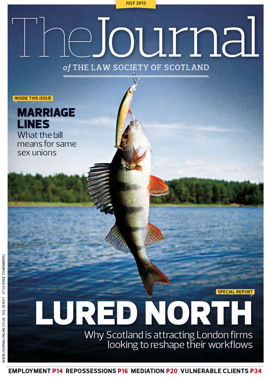Framework remodelled
The Scottish Government exerts a powerful influence on the planning system through the publication of national planning policy, approval and examination of development plans, approving national developments, and operating the appeal function.
Planning is intended to have a key role in the country’s economic recovery, with this being underpinned by a “plan-led” system, reducing red tape, improving performance of planning authorities, and delivering development.
This article focuses on two important Scottish Government consultations in which the consultation period ends on 23 July 2013.
The first consultation, The National Planning Framework 3 [NPF3], Main Issues Report, is the first stage in the preparation for Scotland’s next spatial framework. The second, Draft Scottish Planning Policy, sets out the national planning policy on how development and land use matters should be addressed across the country.
“Main issues”
The National Planning Framework (NPF) sets out how the Scottish Government considers spatial development and land use could and should occur across Scotland over the next 20-30 years. It provides the basis for the designation of a number of national developments, establishing their “need” case with only the design aspects left for future consideration and debate.
It is a pivotal document which underpins and influences development planning at a local level as it must be taken into account by planning authorities in their revision and preparation of strategic and local development plans. It is also highly relevant for the development management process, as it is a material consideration in the determination of planning applications.
NPF3 will set out the Scottish Government’s spatial development priorities. It is clear from the spatial strategy and the proposals in the Main Issues Report that the Scottish Government’s continued focus is on taking forward the spatial aspects of its economic strategy, reflecting its strategic priorities of place and transition to a low-carbon economy and infrastructure development.
The Scottish Government has identified 14 new developments which are considered to be of national importance under NPF3:
- Onshore infrastructure for offshore renewables
- Grid infrastructure improvements
- Baseload capacity at existing sites: Longannet and Cockenzie
- National Cycling and Walking Network
- Metropolitan Glasgow Strategic Drainage Plan
- Central Scotland Green Network
- Dundee Waterfront
- Ravenscraig
- Aberdeen Harbour
- Grangemouth Investment Zone
- Freight capacity on the Forth
- High speed rail
- Airport enhancements: Aberdeen, Edinburgh, Glasgow, Inverness, Prestwick
Scottish Planning Policy
The purpose of the Scottish Planning Policy (SPP) is to set out national planning policies which reflect Scottish ministers’ priorities for the development and use of land. The SPP sets out national policy on all key aspects of the planning system, including sustainable economic development, town centres and retailing, housing, transport, renewable energy, and waste management.
The SPP will have a direct impact on the preparation of strategic and local development plans; the design of development; and in the determination of planning applications and appeals. It is therefore a crucial point of reference for both planning authorities and developers alike.
The Draft SPP sets out six overarching “principal policies” which should be applied to all development:
- Sustainable economic growth
- Sustainable development
- Climate change
- Engagement
- Placemaking
- Location of new development
The Draft SPP states that it is the central purpose of the Scottish Government to focus government and public services on creating a more successful country through the first principle of “sustainable economic growth”. Policies include setting out local development plans to harness the strengths of cities, towns and rural areas, and fostering a business environment which is supportive of new investment while also protecting the natural and built environment. The principles of sustainable economic growth, sustainable development and climate change also demonstrate an increasing recognition of the role of the planning system regarding issues of global concern.
The Draft SPP introduces a number of important changes, including references to maps of “wild land” drawn up by Scottish Natural Heritage which will be “areas of significant protection” in respect of wind farms. It is proposed that the SPP will increase the recommended distance between wind farms and nearby settlements from 2km to 2.5km. A national ban on wind farms in the 19% of Scotland covered by national parks and national scenic areas is also proposed.
The SPP will be finalised by the end of 2013, with the NPF3 being published by 2014.
<>In this issue
- Credit hire: back to basics
- You know who I mean
- Behind all the fun
- Your Future in Law
- Reading for pleasure
- Opinion column: Cameron Fyfe
- Book reviews
- Profile
- President's column
- Mapping out the Crofting Register
- Back office bait
- Another bite at the cherry
- Security of your home
- Marriage redefined
- Building better business cultures
- Keeping a rein on child cases
- Minimum gain
- Beware LLP tax changes
- Framework remodelled
- Scottish Solicitors' Discipline Tribunal
- A Scottish ILG chair in New York
- Beneath the surface
- Being alert to the needs of the vulnerable
- Sins of our leaders
- How not to win business: a guide for professionals
- Litigation: a tight ship?
- Ask Ash
- Why sep rep?
- From the Brussels office
- Law reform roundup
- Diary of an innocent in-houser






